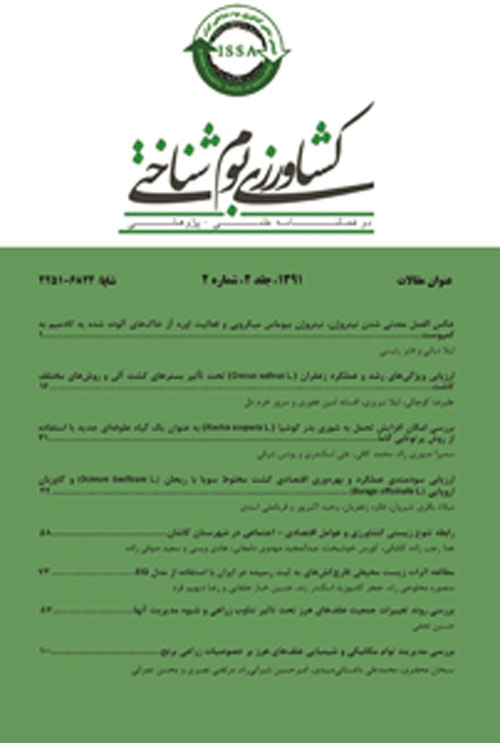Effect of additive densities of barley companion crop on weed management of alfalfa (Medicago sativa L.) establishment
Author(s):
Abstract:
Introduction
Alfalfa (Medicago sativa L.) is the most important forage legume worldwide and, due to its slow growth in the initial vegetation stages, may become highly infested with weeds (Wilson and Burgener, 2009). Thus, methods of sowing and alfalfa development have a significant effect on the crop establishment (Booth et al. 2003). Reliable methods for alfalfa establishment are important for productive and long-lived stands. Sowing a companion crop with alfalfa can help prevent erosion, reduce weed pressure and provide a forage crop before the alfalfa is ready for cutting (Tan and Serin, 2004a). A companion crop is a fast growing annual crop that grows quickly enough to overcome weeds and provides a cash return in the establishment year. The objective of this study was to investigate the impact of different alfalfa and companion crop densities on alfalfa forage yield and weed control in establishment year.Materials And Methods
In order to study the effect of a barley (Hordeum vulgare L.) companion crop on alfalfa weed density and biomass, a field experiment was conducted in 2013-2014 in the research fields of the Plant Protection Research Institute, Karaj. The experiment was established as randomized complete block design with a factorial arrangement of treatments and 4 replications. Two factors including, seeding rates of alfalfa at two levels (30 and 45 kg/ha) and seeding rates of barley at 6 levels (0, 30, 60, 90, 120 and 150 kg /ha) were considered. Traits measured in this experiment included hay yield, weed density and biomass in the first cut and hay yield and weed biomass (if any) in second, third and fourth cuts.Results And Discussion
Results showed that increases in alfalfa seeding rates from 30 to 45 kg/ha, significantly increased annual hay yield (8.6%). Increases of barley companion crop seeding rates also caused a significant increase in annual hay yield in comparison with pure alfalfa, as greatest hay yield (80.57) was observed in 60 kg seeding rates. Weed density and biomass of first cut was influenced by additive intercropping treatments of alfalfa and barley. Use of barley as companion crop, in addition to reducing weed density and biomass, suppressed alfalfa plant growth and reduced the percentage of alfalfa in the first cut hay yield. Residual effects of barley were seen in the subsequent cut, so that different densities of barley reduced weed biomass compared to the control in the second cut. The results of this study showed that use of barley as companion crop can play significant role in reducing dependence on herbicides and increase forage quality. Based on results from the first year, the seeding rates of 45 and 60 kg ha-1for mixed cropping of alfalfa and barley respectively, in addition to increases forage production, can control weeds effectively.Conclusion
The results of this study indicate that barley reduced both weed competition and alfalfa growth, but increased total hay yields in the establishment year. The residual effects of the companion crop on weed suppression continued in the second cut. In most cases, the 45 kg/ha alfalfa seeding rate was superior. Sowing the barley at a higher seeding rate of more than 60 kg/ha appeared to depress initial growth of alfalfa in the seeding year, especially at the first harvest. The results showed that alfalfa can be successfully established with a companion crop. Based on the first year results and in order to achieve the best result, it is suggested that alfalfa and the barley companion crop be sown at the 45 and 60 seeding rate respectively. Keywords:
Language:
Persian
Published:
Journal of Agroecology, Volume:6 Issue: 1, 2016
Page:
135
magiran.com/p1586439
دانلود و مطالعه متن این مقاله با یکی از روشهای زیر امکان پذیر است:
اشتراک شخصی
با عضویت و پرداخت آنلاین حق اشتراک یکساله به مبلغ 1,390,000ريال میتوانید 70 عنوان مطلب دانلود کنید!
اشتراک سازمانی
به کتابخانه دانشگاه یا محل کار خود پیشنهاد کنید تا اشتراک سازمانی این پایگاه را برای دسترسی نامحدود همه کاربران به متن مطالب تهیه نمایند!
توجه!
- حق عضویت دریافتی صرف حمایت از نشریات عضو و نگهداری، تکمیل و توسعه مگیران میشود.
- پرداخت حق اشتراک و دانلود مقالات اجازه بازنشر آن در سایر رسانههای چاپی و دیجیتال را به کاربر نمیدهد.
In order to view content subscription is required
Personal subscription
Subscribe magiran.com for 70 € euros via PayPal and download 70 articles during a year.
Organization subscription
Please contact us to subscribe your university or library for unlimited access!


